Rose Step by Step Instructions Rose Drawing Step by Step Easy

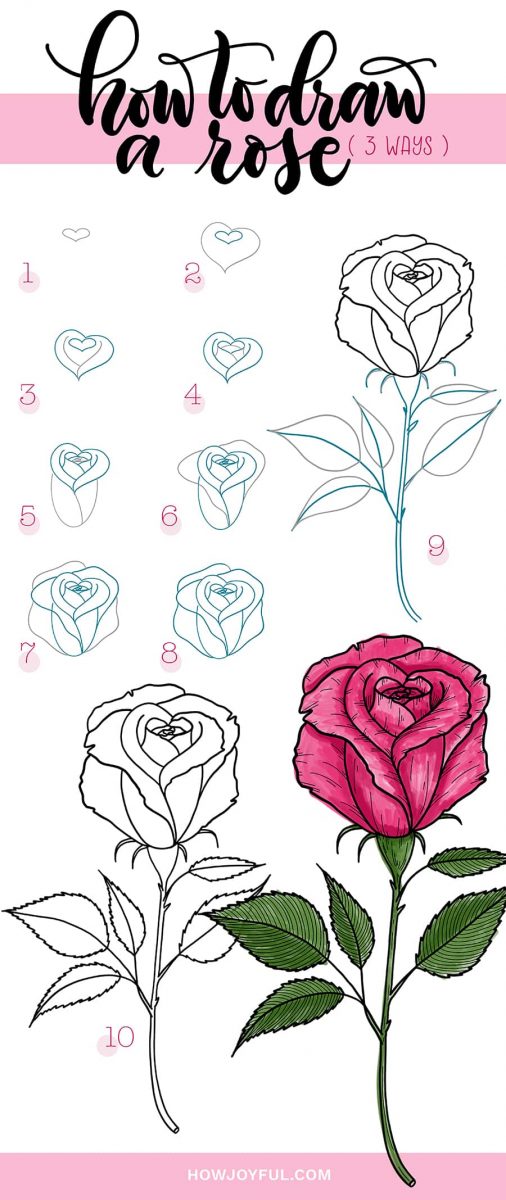
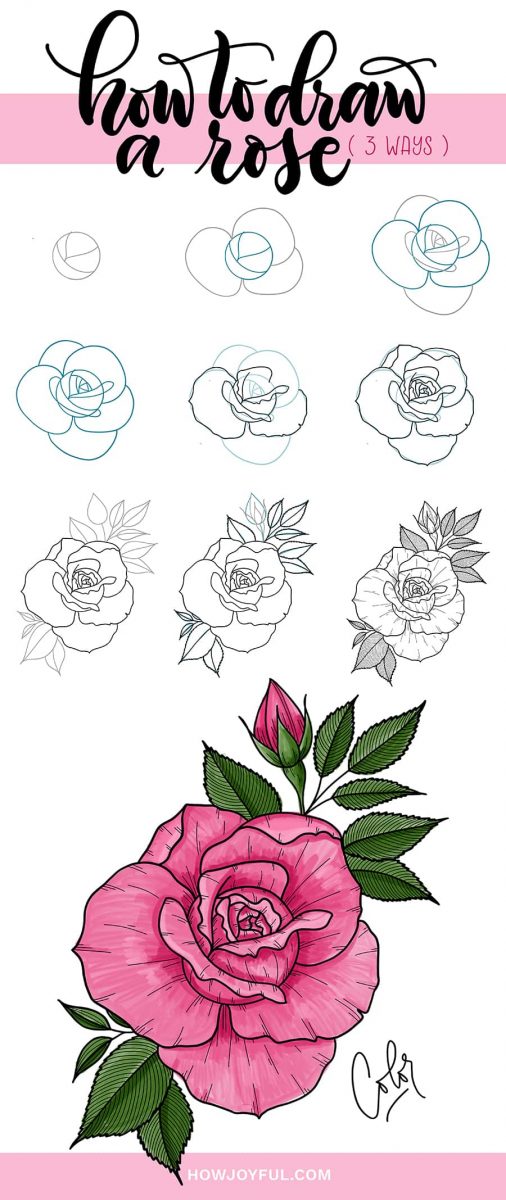
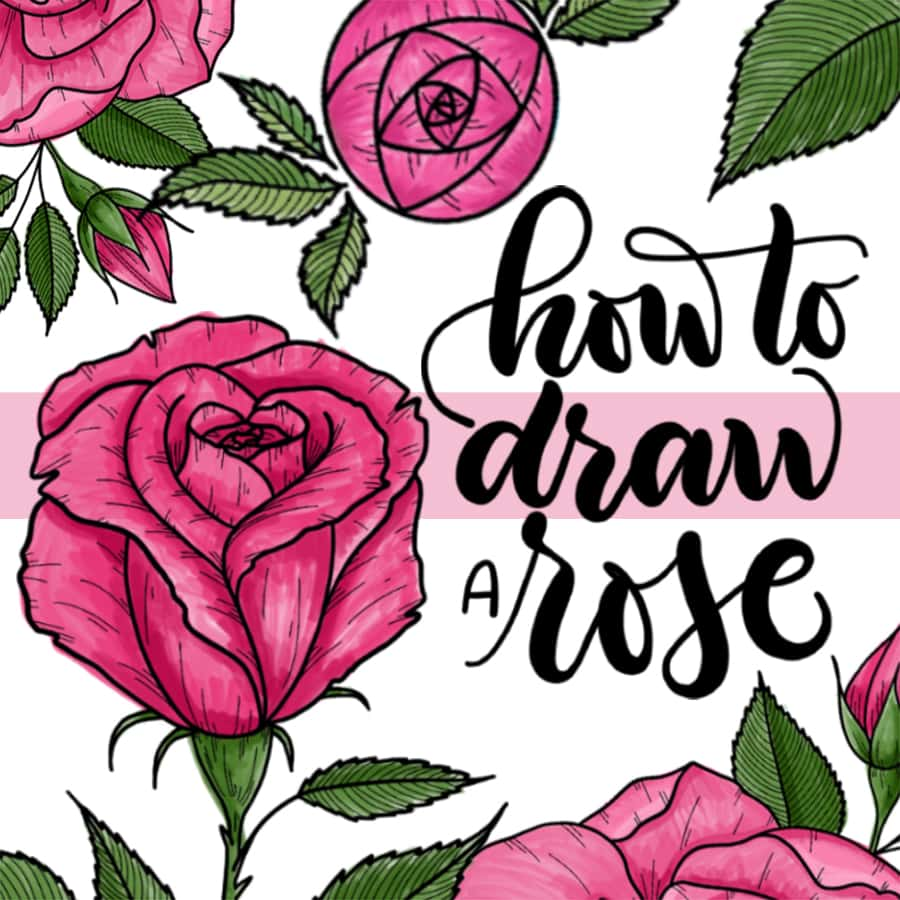
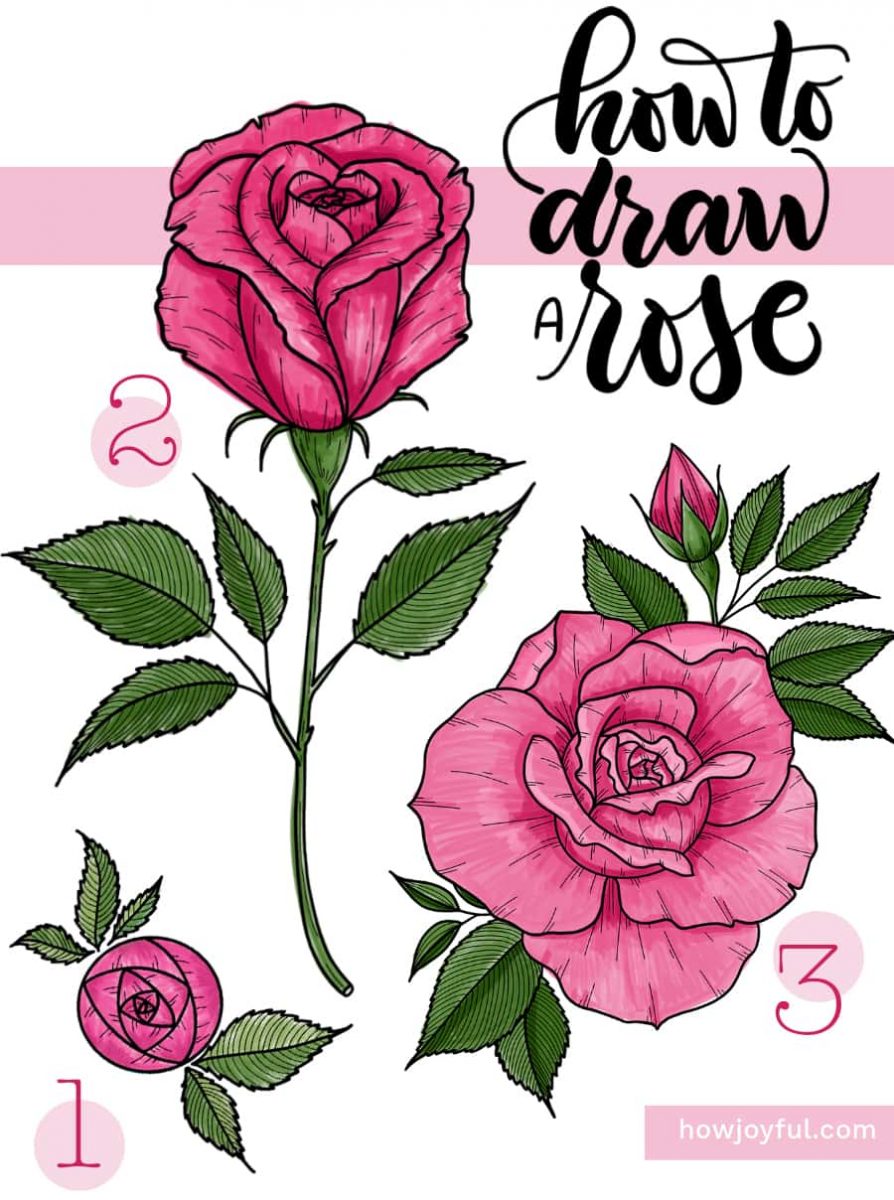
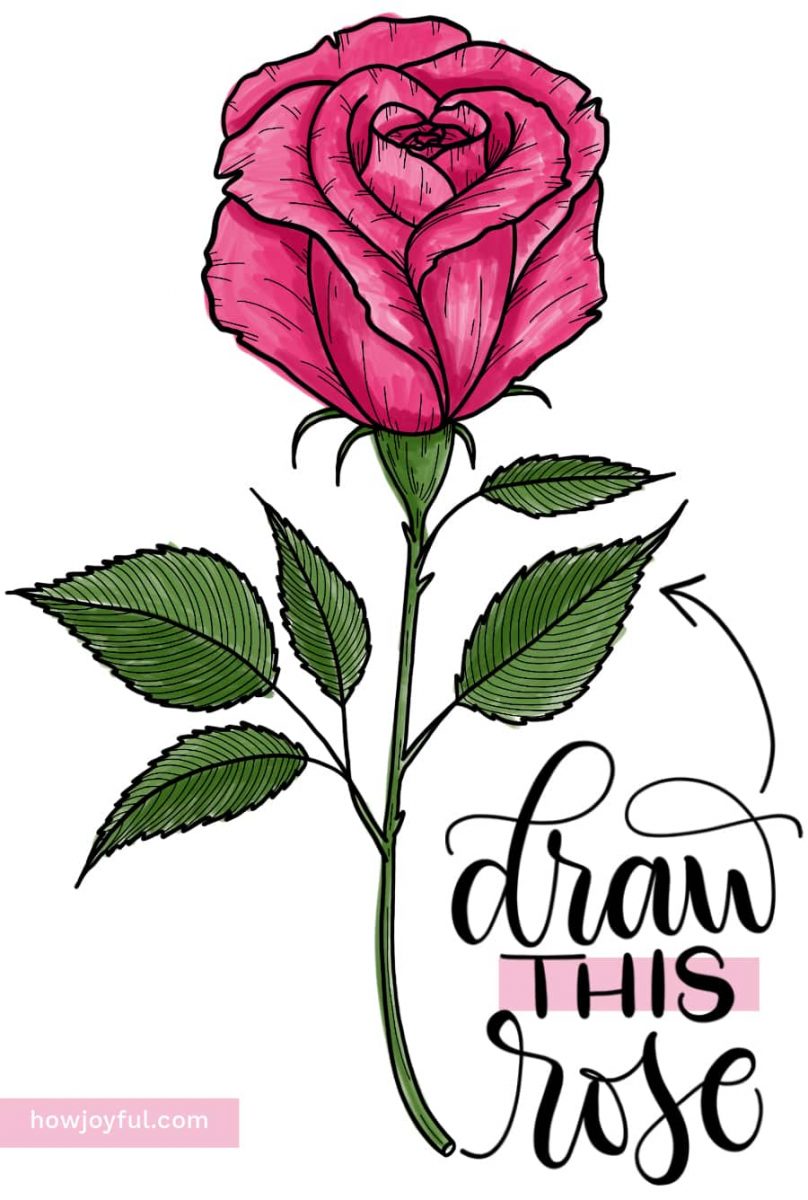
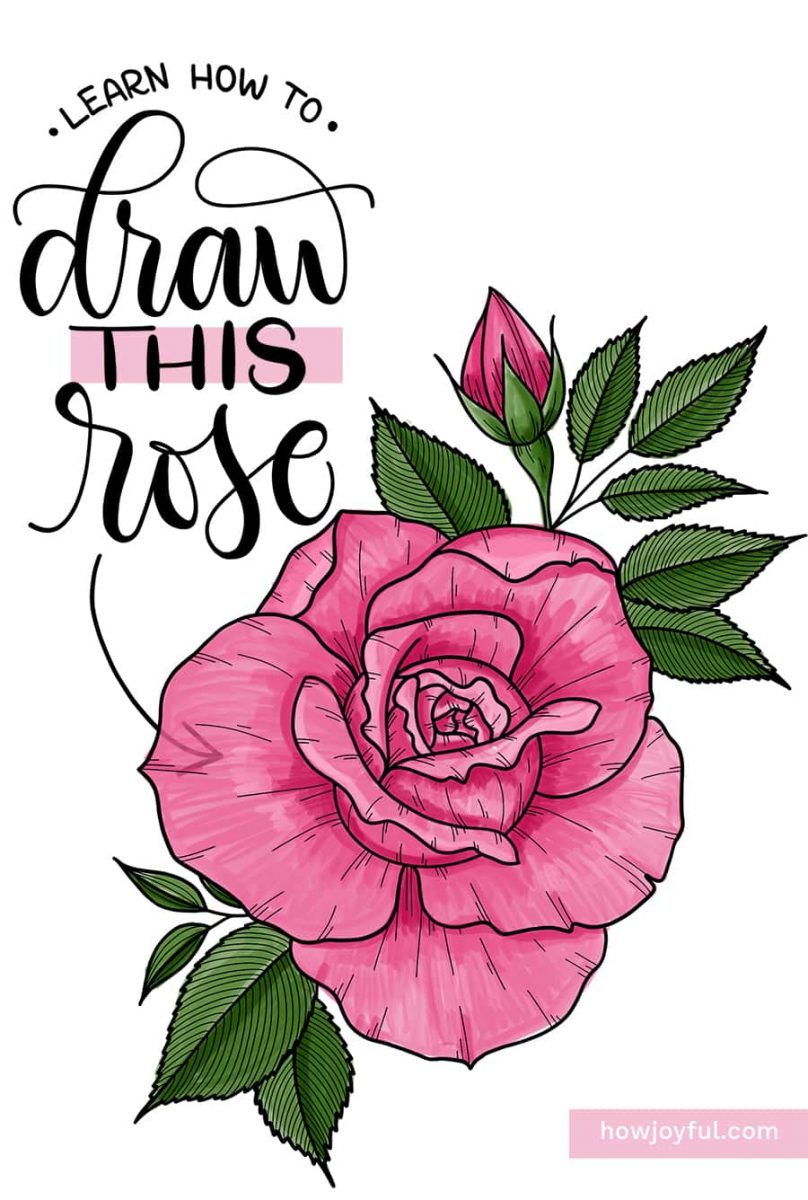


Check the 3 different drawings of roses and the easy step-by-step instructions on how to draw each one of the rose styles to spice up your lettering, calligraphy pieces, or bullet journal spreads.

In this beginner tutorial, we will go over how to create three different ways to draw a rose following detailed steps on how to draw a rose.
No matter the tools you are using for drawing. If you want to sketch using pen and paper or digitally with an iPad and Procreate. This tutorial can help you get started with rose doodling.
I believe that getting started with drawing flowers doesn't have to be intimidating, this is why I am sharing 3 different ways to draw a rose that will build your confidence as you move from easiest to modern advanced. That way we can build up to more advanced shapes.
This drawing tutorial will help you feel more confident in your drawing skills so that you can conquer more difficult or realistic ways to draw a rose in the future.
In this post, I will cover
- Anatomy of a rose
- Drawing supplies
- Sketching tools
- Inking tools
- How do you make a simple rose ( 1ts way)
- Easy to draw Rose from the side (2nd way)
- Rose drawing from the top (3rd way)
- Sketching roses – Practice makes better
Anatomy of a rose
In order to draw roses, it is important to know a little about anatomy, just like we did in the leaf drawing tutorial post. Because there's no better reference when we draw something than the real thing.
Most of my sketches of roses come from live references of from real pictures of flowers, so let's check at the parts of a rose:

- Flower head (corolla): The second of a series of flower parts growing from the peduncle, composed of petals.
- Petals: One of the units of the corolla of the flower. Roses have from four to over 100 petals, depending on the variety.
- Sepal: These are the green coverings of a flower bud that opens to reveal the petals of the rose. Roses usually have 5 sepals.
- Peduncle: The main stem of an individual flower or of a spray.
- Leaf: An organ arising laterally from superficial tissues of a shoot apex. It is usually flat and may be simple or compound.
- Three leaflet leaf: The leaves are alternate and feather-formed (pinnately compound), normally with oval leaflets that are sharply toothed.
- Thorn: They are technically prickles, outgrowths of the epidermis. A branch of a plant that becomes woody, hard, and pointed.
- Stem: The base of a flower, it's the main body or stalk of a rose.
Drawing supplies
First, we do need to cover what you will need to start sketching, because even though you can draw these doodles with whatever you have around, if you are ready to test something else, here is the list of all the things I use for drawing, sketching and inking.
If you are looking for sketching paper, this HP paper rem that I recommend to start using with Brush Calligraphy is also wonderful for doodles, you can also use tracing paper to create "layers" and correct your drawings. I also recommend this journal in case you don't have one, and this notebook in case you want to add watercolor details, or you want to make sure there's no bleeding on your pages since you can color and sketch on both sides of the pages, it's awesome, get it here!.
Below are some of my favorite tools, but as I always say, just start with what you have, even if that is a napkin and a pen. Get started drawing and sketching now and buy materials later down the road =]
If you want to work on your iPad instead, here you can see a list of my current digital drawing setup and recommendations. Also, here you can read all about the Procreate brushes I use and recommend.
Sketching tools
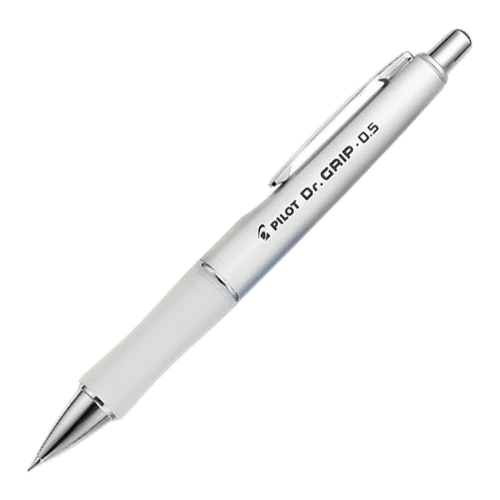
Pilot Dr. Grip Mechanical Pencil
I love how thick this mechanical pencil is (0.5mm), I always have it in my travel pencil case (if my boys don't steal it). The grip is super comfortable and changing the lead to a softer one will give you so much control and shades.
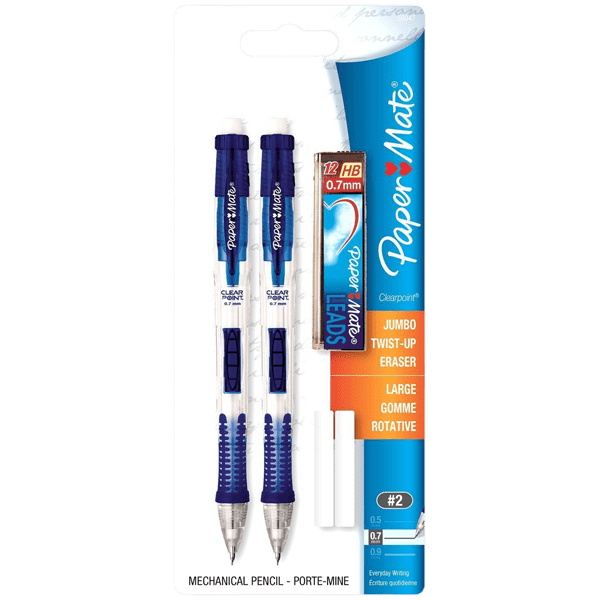
Paper Mate Mechanical Pencil Pack
I love having a bunch of these around for when I want to sketch something really quick, and the 0.7 mm size is my favorite ever! And while they come with HB leads, just like any other mechanical pencil, you can add a different softness of leads. I like to add strikers and I have them in different colors to differentiate the leads.

Pentel Triangle Eraser
This is my absolute favorite eraser, I first purchased this one while still in college back in Chile, it was the older version but the same concept. I love that the shape of the eraser gives you three sharp points that you can use to be more precise, it's way better than the round ones in my opinion. Also, it's a great alternative if you don't have an eraser shield.

Staedtler Eraser
There are some things that once you find the brand that you love, you just stick to it and never look back. For me the Staedtler erasers are it. I've been using them since my early college years and absolutely love them!
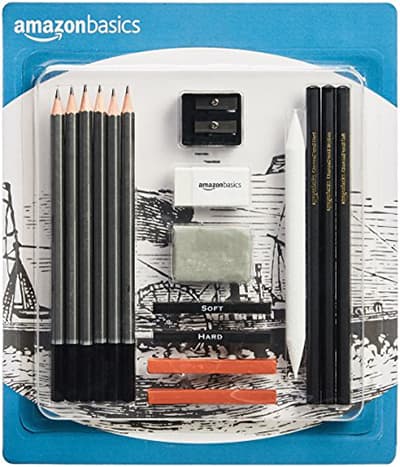
Amazon drawing pack
If you want to experiment with the different softness of pencils, this pack offers 6 different softness of graphite pencils, 3 charcoal pencils, 1 sketch stick, 4 charcoal sticks, 1 pencil sharpener, 1 charcoal sharpener, 1 kneaded eraser, and 1 white plastic eraser.
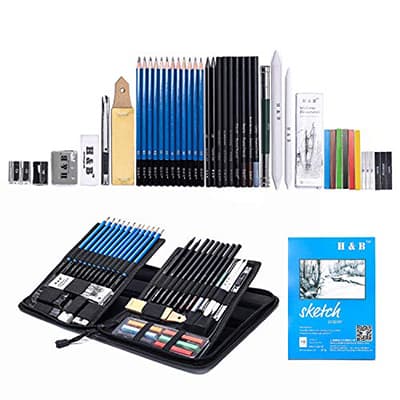
Sketching pack (48 pieces)
If you are looking for an even more complete option, that is also very budget-friendly, this pack offers pretty much everything you would need (paper included). It even comes with a pouch so you can carry all your pencils and tools.
Inking tools

Faber-Castell Pitt Pen set
This pack is awesome for lettering because you get a wide variety of thickness and also one brush pen, so if you want to start lettering but you are not sure if brush calligraphy is for you, you can just get this and start practicing with the one included here. They are a great deal too! (Instead of buying them in singles)

Staedtler Lumocolor Fine Point
I love that this pen can be refilled (the refill station is sold separately) but if you are doing a lot of work, something like this comes super handy, I was using SO MANY pens, until I found this kind of refillable ink pen. They are not as cheap at the beginning but worth every penny in the long run.

COPIC Multiliner Pack
I was also introduced to this multi-liners during technical drawing in college, but it took me a while to find them here. I love that these particular ones have a great range of thickness, they are refillable and you can also replace the nib. These features are awesome because I can go through one pen in just a couple of days, so this feature really helps my wallet (and can save you a ton too!)

Tombow Fudenosuke Brush Pen
This brush pen set is by far my favorite when it comes to learning, it comes in a soft and hard version. Even though the difference is not huge, you can make a little bit thicker downstrokes with the soft tip. They handle pressure amazingly good and if you use them with the correct paper (read my paper recommendations ) they can last you a long time. They come in different colors that are bright and so pretty.

Pentel Fudenosuke Brush Pen
This one is my second favorite fude brush pen, you can also get it in a bunch of awesome colors, and that is always a plus! (you can see them linked below) I love how durable they are and they have lasted me way longer than I thought they would.
How do you make a simple rose ( 1ts way)
The most simple way to draw a rose is by doing a circle doodle motion, so let's check out how to draw this flower step-by-step.

1 – First draw a small circle. This will be the body of the rose. Jut as with any doodle, this doesn't have to be a perfect circle =] After that, you will draw a line finding the middle points and rotating them to one side.

2 – The process to create the inner petals is very simple, but in the beginning, it can be a little confusing. To help with that I always like to think about how the following line always starts where the previous one ended.

3 – For each petal, we will start where the previous stroke ended, and we will aim to hit at around the center of the opposite side, with a slightly curved line. Again this doesn't have to be perfect. Imperfection actually adds to the charm of the rose petals.

4 – The lines will become smaller and closer together when we are starting to reach the center of the rose, so depending on the initial size of the circle we used to start the rose. There can be as many or as few petals as we want.

5 – I like to get as close as possible to the other lines when I am drawing the center, this way it would look a tad more like a rose since the center is always very tight with petals.

6 – To add a little extra to the doodle rose, I also added a few leaves, for these I decided to do two clumps on each side. I started by making lines where the vein of the leaf will be, then drawing the sides.

7 – After my guides for the leaves were done, I inked on top and gave the signature toothed-edges that rose leaves have. To give it a little extra visual impact, I address thin lines to the leaves and added some details inside the rose petals. While this is not necessary, personally like how much depth this gives to the rose.

8 – To finish it up, I added some color to both the rose and the leaves. I used two different green shades for the leaves, using them consistently on one side to give a light and darkness effect. The same thing with the rose, I used shades of pink instead of the classic red rose. Added a lighter color towards the upper edges and a darker color towards the bottom of the leaf.

Easy to draw Rose from the side (2nd way)
This rose looks a little more realistic than the first one, but it's still easy enough for beginners, If you follow each step I share for how to draw this cute rose, you should be able to get similar results and with practice, your rose not only will look better but eventually, you will not need guides to draw them.

1 – We are going to start by drawing a small and wide heart shape. This will be the center of the bulb of the rose. After that, we will draw another heart, but this time longer and less wide. We will also place the top center of the heart off to the side, this way it will have a more organic look to the center instead of a perfectly symmetrical one.

2 – Now we will define the center petals, starting from the center of the bigger heart. We will follow the side edge of the heart. For the opposite side, we will start a little above the center point and mirror the first stroke. After that, we will draw lines from the small heart down as shown below and another across the heart in a curve motion.

3 – Next we will draw an elongated ellipse and continue the line from the bottom of the bigger heart until it touches the bottom ellipse line. And just like on the first round rose, we will make lines for the center of the rose. After that, we will start with the outer petals, for the first one, we will start at the bottom point of the oval and draw an uneven line, make sure you go below the top of the bigger heart to give it a more fluid look.

4 – For the second outer petal, we will draw uneven shapes on both sides and also on the top, the goal is to make an overall symmetrical flower head. This shape will be the guide that we will use to ink the rose, we will use more organic lines, especially on the edges, to give it a more petal-like look.

5 – I really like adding little intents to the top-center of the petals that are completely open, this makes a cute detail and makes it look a little more realistic even though we are using simple shapes. After that, we can start sketching the stem, sepals, and peduncle.
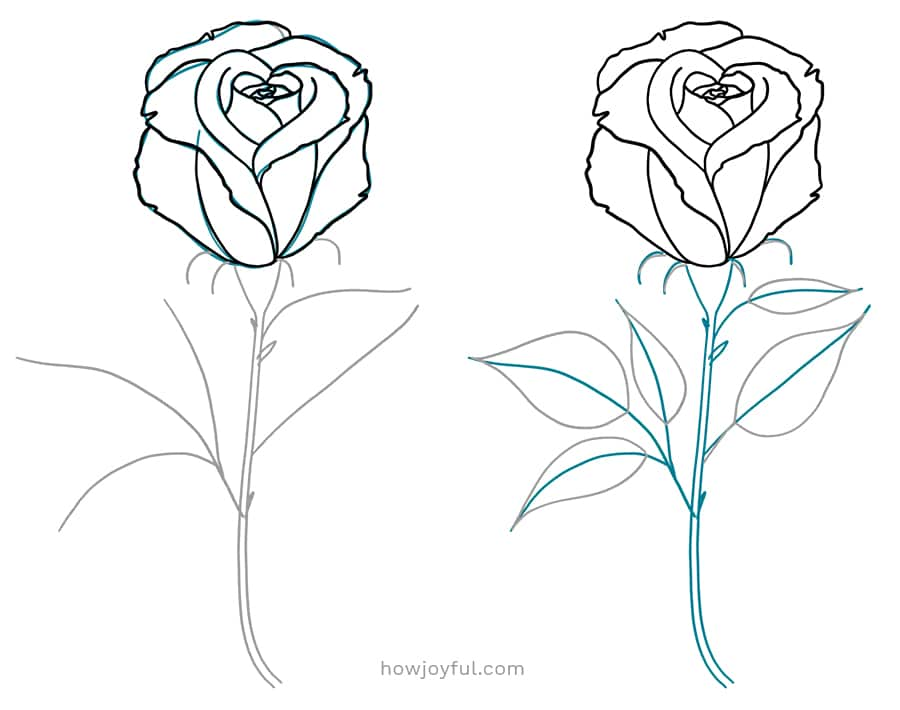
6 – As we did before, use the guides to draw the leaves. I have a very detailed post about how to draw leaves right here. Ink the final rose or just use a softer pencil to make the lines thicker and bolder. Erase or get rid of the guides before adding the final details.
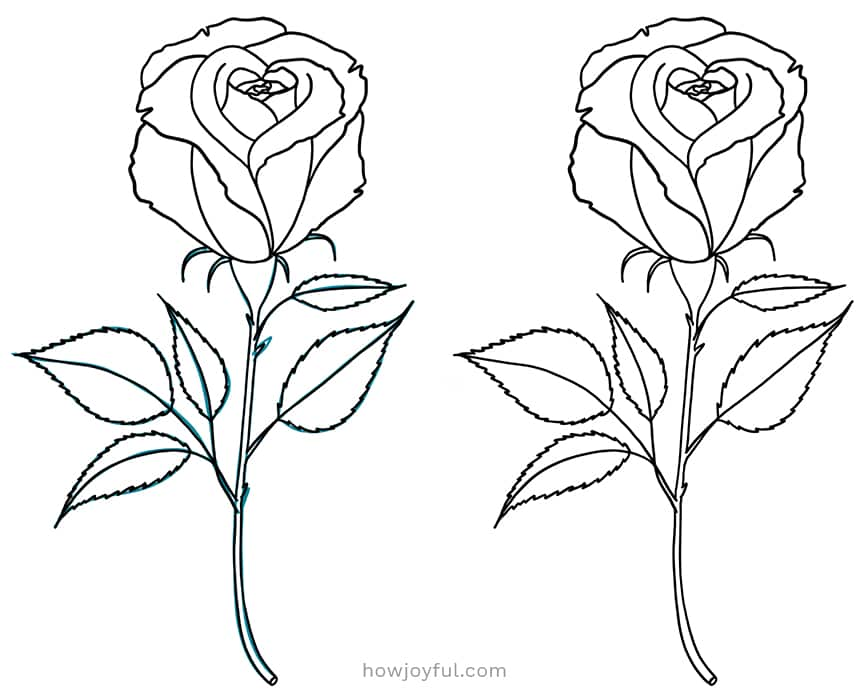
7 – Use thinner lines to create texture in the leaves and details in the rose by following the natural shape of the petals and what would be shaded in the rose. I really like how much impact some lines can have in a simple drawing like this. I finish the drawing by adding color, just as before, I used a hot pink color instead of the classic red rose. And for the leaves, I used two shades of green. Since I color this digitally, I used the textured brushes from my Procreate pack to add more dimension.
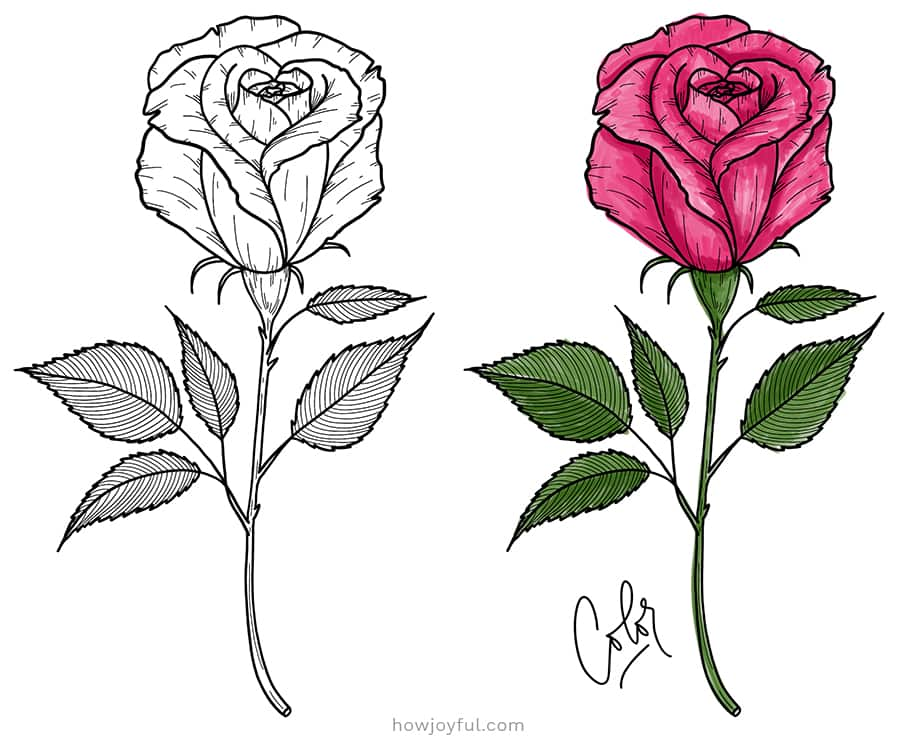
Rose drawing from the top (3rd way)
Out of the three versions, this is the more realistic rose drawing. But it does not have much detail because we are not really going for a fully realistic look. This time, we are approaching a top view of the flower and I added a small rose bulb to make the illustration drawing a little fuller.

1 – For the final rose, we will start with a circle and draw a moon-like shape tilted towards one side. then from the center draw a V-like shape having one side bigger than the other. Then draw a petal on one side, continue with another on the upper edge, almost divided in 3, but instead of drawing them next to each other, the last two will intertwine.

2 – Now add the upper and lower petals to finish the outer shape. For the inside, add an outer-round shape to the lower part of our moon and to one of the sides as shown below. This will be the guideline for the head of the Rose. Use the technique we learned in the first rose to create the very center portion.

3 – To make the rose as organic and realistic as possible, use uneven lines on the edge while making the final lines, as we did with the previous rose, make little indents in the center-top of the outer petals. Follow the example below to finish up the drawing of the head of the flower.
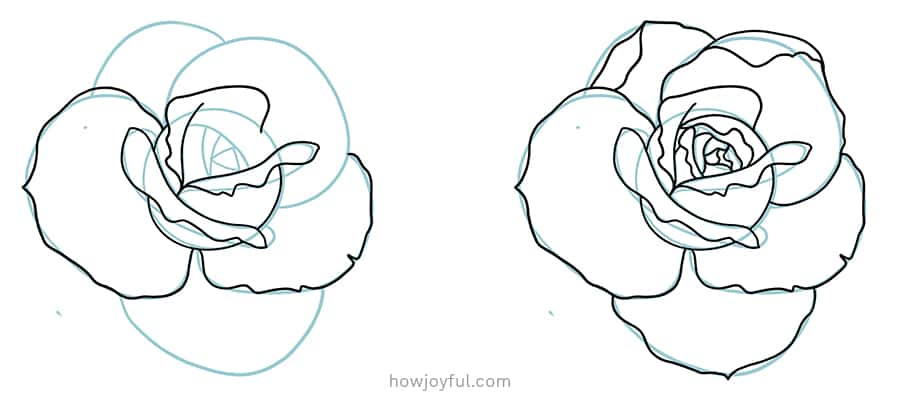
4 – After inking the flower, draw leaves on both sides of the rose just as we did with the previous flowers. This time we are also adding a bulb, for this we will start with a leaf shape with a round bottom. Once the guidelines are ready, ink the leaves and add tooth-shaped edges. For the bulb draw guides as shown below dividing the bulb in three to accommodate for the sepals. Divide the top towards the side to show two petals.

5 – As we did before, using thin lines to create texture on the leaves and details on the head of the flower, check where the petals would naturally fold and add lines there. In my case, I used my Procreate brushes to add color to the rose. Using hot pink and smudging a lighter shade of pink where the light would touch the petals and leaves.
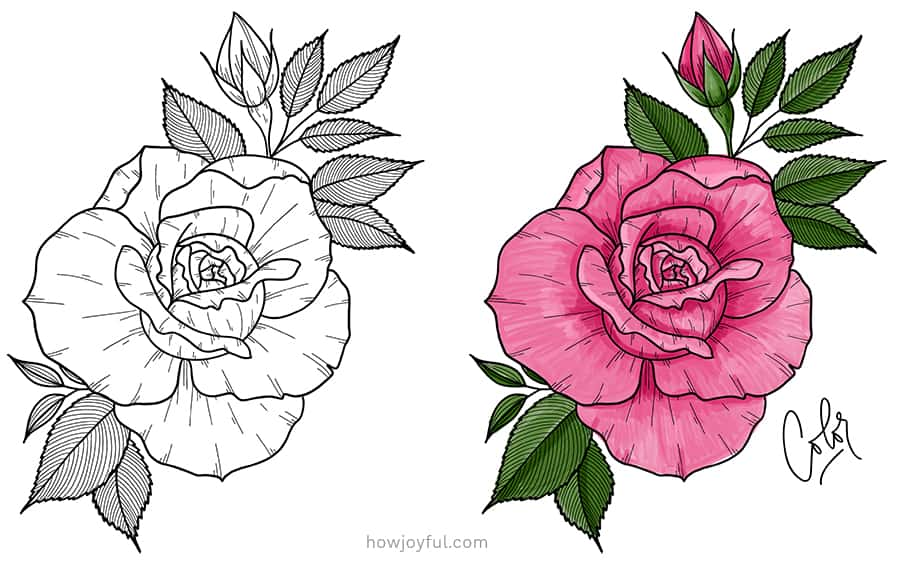
Sketching roses – Practice makes better
Just like with anything new, you will need to practice in order to see progress, sketching roses is not super easy, roses are complex flowers to draw (unless you are drawing the first style I shared here) the more realistic we get, the harder is to imagine how the petals will curl.
If you want to experiment with different views, and further improve your rose-drawing skills I recommend you to look at a real rose for reference. Or you can check pictures of real flowers for line drawing inspiration (I made this board on Pinterest) I also created a specific section inside that board for just Rose pictures.
If you want to save this post for later, just pin the images below =]
I will add more tutorials for drawing soon, so make sure you come back! And take a look at this post with 100+ easy things to draw ideas for your lettering pieces or bullet journal.
Happy drawing!
Source: https://www.howjoyful.com/drawings-of-roses/
0 Response to "Rose Step by Step Instructions Rose Drawing Step by Step Easy"
Post a Comment